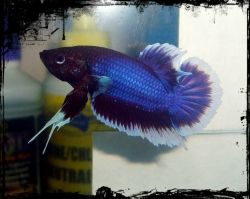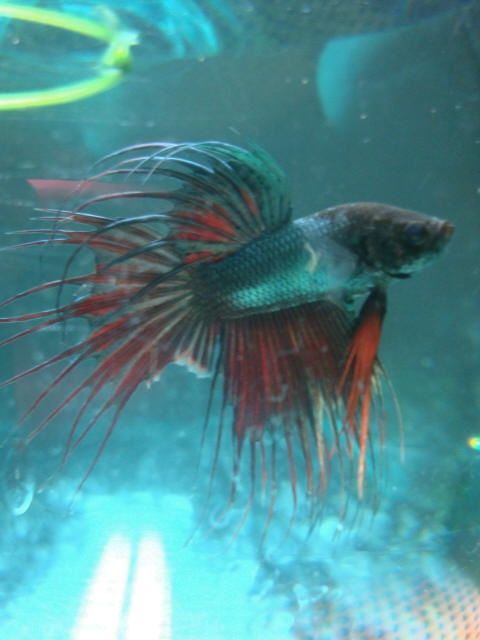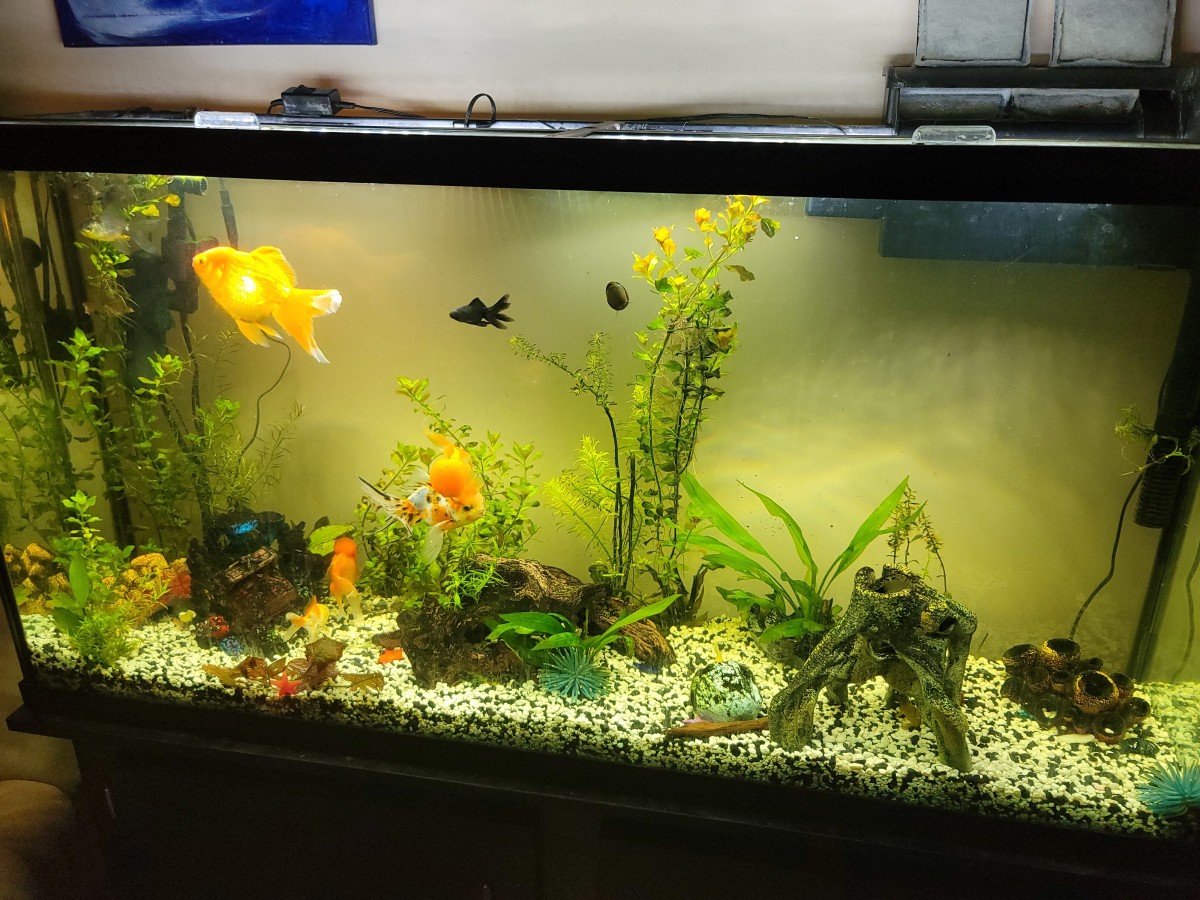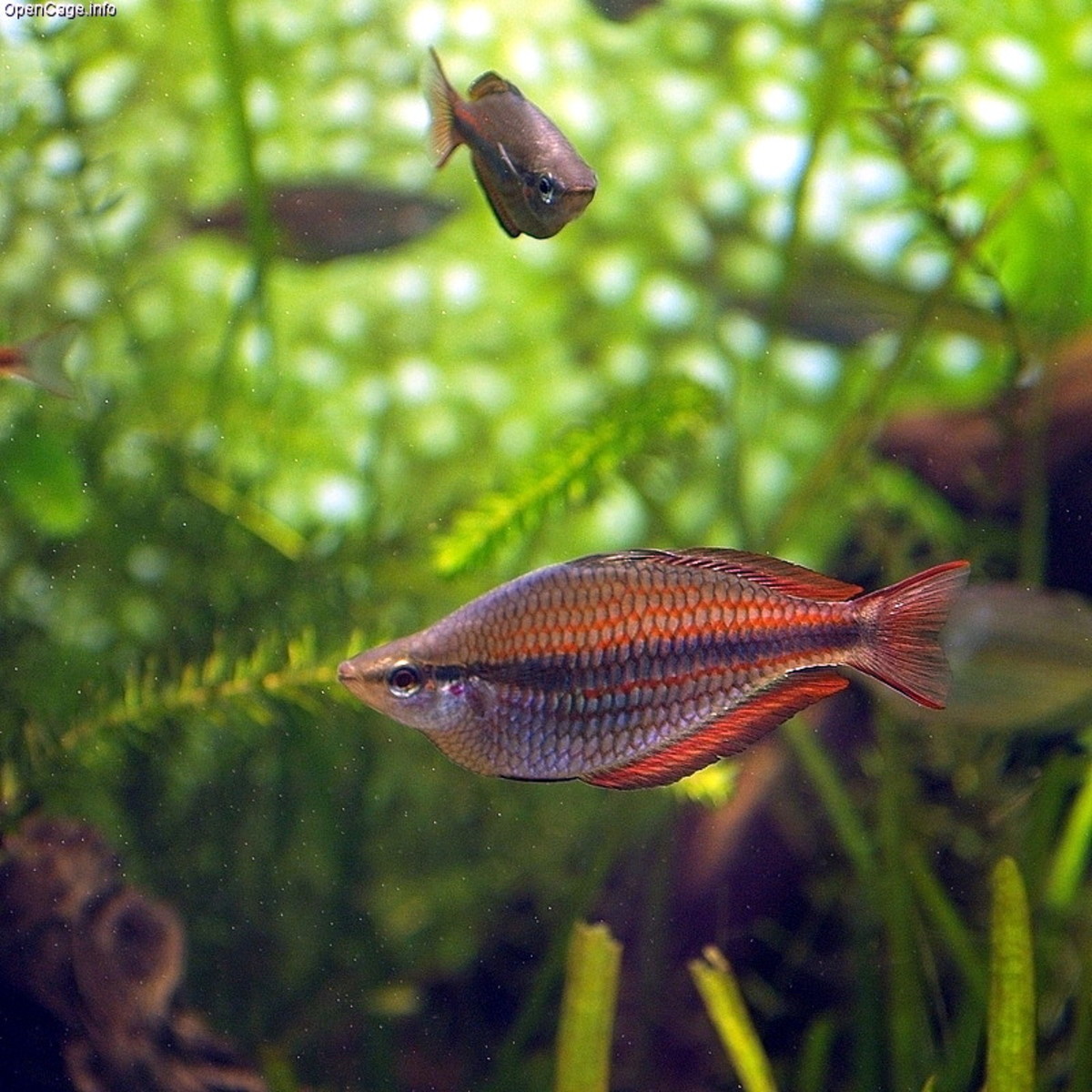Betta Addiction - Betta Fish FAQ

Betta FAQ's
This is where I'm going to post Frequently Asked Questions about bettas. I'm not a betta expert myself and some of the answers I give here are based on my own experience with bettas, while most of them I learned by inquiring from betta enthusiasts whom I know. If you have questions not found in this lens, feel free to drop them in the the comments page and I will answer them accordingly. Thank You!
1.) Can I keep two male bettas together in one tank?
Answer:
YES.........
What are you thinking? Of course NOT!!! Male bettas are meant to live in peace ALONE. Bettas are aggressive and territorial in nature. If you keep two male bettas together in a small tank, they'll end up tearing each other's fin or even killing each other. They're not called "Fighting Fish" for no reason. If you want to keep two male bettas in a large tank, make sure you place a divider between them where they can see each other but not come in contact with each other. About female bettas, you can keep up to five in one 5-10 gallon tank. The first time you place female bettas together, they'll establish a "pecking order" so don't be surprised if you see one of them acting boss and chasing the others around. After a few days, they'll all be in peace with one another as long as you don't put another female betta in or remove the "alpha" female.
"What about putting one male betta along with a few female bettas?" you may ask. Well, the only time you can place a male betta together with a female betta is when they are ready to spawn and make some babies. So, unless you're not serious about breeding bettas yet, just stick to the "one male betta per tank" rule.
2.) My betta won't eat, what do I do?
Answer:
This is a question most betta keepers like me ask all the time. Normally, a betta would eat like a pig if you feed him with something he loves like live brine shrimp or frozen bloodworms. If your betta refuses to eat, it's either he's sick, he's sulking, or he doesn't like the food you're feeding him. If you have your betta for a long time and one day you feed him and he doesn't eat, it's probably because he's sick. Check the water condition if it's still normal. Fish react to frequent changes in water quality so if you just made a water change, it could be that your betta is in stress and won't eat. Let him settle for a while and feed him later when he's not so stressed anymore.
If you just bought your betta from the petshop or from a breeder, chances are, your betta will only eat what he has been used to eating back from where you bought him. This is quite normal for bettas especially if you feed them something totally different from what they grew up with. For instance, if they've been fed live food all their life, they'll simply ignore what you'll them even if it's bloodworm. I've experienced buying my first Crowntail betta from a well-known breeder here in our place and when I placed him in his tank and tried to feed him, he simply spewed the bloodworms out. My other bettas would go crazy over bloodworms and pellets but not this new betta I just got. He's been used to eating live mosquito larvae that's why other types of food seemed foreign to him. What I did was I let him go for four straight days without food. I occasionally dropped some bloodworms or pellets in his tank to let him understand that they are food. For three days he just ignored them, or bite them but eventually spew them out. Finally, on his fourth day in his new home, he snapped out of it and gobbled every little piece of bloodworm I gave him. He still ignores the pellets though.
If your betta won't eat because of a disease, it's time for you to bring him to a betta doctor, or you can follow my advice and play doctor yourself. To treat a sick betta, isolate him and place him in water treated with anti-fungal or anti-biotic betta medicine. If you are successful and your betta gets well, his normal appetite will return.
3.) How will I know if my betta is sick?
Answer:
There are several ways to recognize whether your betta is sick or not. You have to be prepared for the worse because you never know when your betta will get sick. Initially, you should be armed with betta medicine such as those that treat bacterial infection, fungal infection, fin rot, ick, etc. You should also get some preventative medicine for your betta if you don't want him to get sick in the first place. Moving on, if your betta is healthy, he will normally swim around his tank actively. He'll also eat his food as usual and flare at you from time to time.
If your betta is acting strange and is not swimming actively or eating as usual, look for signs that might tell whether he's really sick or not. Here are the most common signs that your betta is infected with a disease:
-Rotting Fins
-White Spots/Red Spots
-Open Sores
-Swollen Gils
-Raised Scales
-Bloated Stomach
If your betta shows any of these signs, isolate him immediately and check this site out Betta Addiction - Betta Diseases to find out how to treat your sick fish the best way.
A Very Healthy Betta - My Crowntail Betta Squidoo
This is a video of a healthy Crowntail Betta. He's my betta named Squidoo. I named him that way because I love Squidoo.com and he looks like a squid when he swims LOL!
More Betta Questions?
If you have a question not found in this lens, feel free to drop them on the comments page so that I can include them here and answer them for you. Thanks!
4.) How often should I feed my betta and how much?
Answer:
A common mistake done by most betta keepers is overfeeding their pets. Unlike other tropical fish, bettas won't stop eating as long as there is food in their tank. To give you an idea of how much food to give your betta, take a look at his eyes and see how tiny it is. That's exactly how small his stomach is. Imagine filling that small belly with a lot of food. What do you get? A bloated stomach. Or worse, swim bladder disease. If you are feeding betta pellets to your fighter, 2-3 pieces per meal is enough. See to it as well that he gets a variety of food and not just pellets. If possible, give him special treats once in a while like frozen bloodworms or live brine shrimp. When it comes to blood worms, 4-5 per meal is ideal.
Adult bettas should be fed once a day. On the other hand, betta fry should be fed twice a day but make sure you remove excess food as soon as the fish are done eating to maintain the quality of their water.
Actually, what you're after is to give your betta enough food to make his belly look round but not bloated. In addition, you might also want to skip a day in feeding so that your bettas digestive system will have a chance to rest. In my case, Friday is NO FOOD day for my bettas. It's my way of "detoxifying" them.
Buy Frozen Bloodworms Today!
Frozen bloodworms are the only type of food I feed my adult bettas simply because they're both nutritious and is a lot less messy to handle compared to live food.
Baby Brine Shrimp For Your Betta Fry!
Betta fry should be fed twice a day with live food such as baby brine shrimp.
5.) How do I clean my betta's tank?
Answer:
It depends on how large your betta tank is. For 2.5-5 gallon tanks, you should perform a FULL water change at least once a week. For individual jars, FULL water changes are required every 3 to 4 days. You'll also need to siphon your tank to get rid of debris that are trapped underneath the gravel. I know this is not the answer to the question "how do I clean my betta's tank?" but I included it here so that I won't have to make another section about "how often should I do water changes?"
Now for the real answer. The degree of difficulty of cleaning a fish tank depends on the size of the tank itself. Unlike larger tanks, tanks that are 2 gallons and smaller can be easily cleaned as you can simply take your betta out, dump the dirty water, and clean it. However, you should understand that in order to maintain the health of your betta, you have to learn the proper way of handling him especially when doing some water changes or tank cleaning. Let me show you I clean my betta tank.
For my 2.5 gallon tank, this is what I do:
1. Using an airplane cup, I scoop my betta from his tank very gently. I found this safer than using a net because a betta's fins can easily be torn if you don't know how to use a fishnet on him. Using a plastic cup on the other is very easy since you can just scoop him up and place him on a safe place while cleaning his tank.
2. I remove all accessories from the betta tank, including live plants and pebbles and place them in a different container where I can clean them later on. When the tank is empty, I proceed to cleaning it. I use a scrub that's intended for this one tank alone and I don't use soap as the chemicals from it can be deadly to my betta. I just use plain water.
3. Next, I clean the pebbles by placing them under running water. I also make sure no debris are left on the plant leaves.
4. When everything has been thoroughly cleaned, I return the pebble inside together with the plant and other accessories inside the tank.
5. A day before I perform the cleaning, I already set aside a 2 gallon container that I have treated with water conditioner. I use tap water so I make sure the water is safe for my betta by treating it and letting it age beforehand. Allowing the water to settle overnight is enough to get rid of whatever harmful substances are in there. I also add my own betta medicine to make sure the betta is free from any fungal or bacterial infection.
6. When everything's set, I gently float the cup where my betta is on the water to allow the temperature inside the cup and in the tank to even out. I don't wait too long because I live in a tropical country and I have no problem about water temperature differences. If you're living in a cold country though, you have to make sure you set the water temperature from 75-82 degrees Fahrenheit before adding your betta.
7. After acclimating my betta for a few minues, I gently release him into the tank. He just loves it when his water is clean and he shows his appreciation by building a bubble nest hehe.
Ideal Tanks for Your Bettas
Bettas do well in tanks with water capacity of 3 to 5 gallons.
6.) I've noticed some tears on my betta's fins. How long does it usually take for them to heal?
Answer:
There are several reasons why a betta's fins get torn. One is maybe his fins got caught in a sharp object inside his tank like a leaf or a tank accessory while he was swimming around. Another is maybe because he's a tail biter (Some bettas nip their own tail). It can also be because he's sick and is suffering from fin rot. When bettas spawn, a fight may occur between the male and the female as part of their ritual and this too can be a cause of fin tearing. In addition, bettas fins can also get torn when they flare too much like in the case of halfmoon bettas. Such phenomenon of tearing a fin due to overactivity is called "blowing a tail."
If your betta is not sick at all, and is obviously not suffering from a fin rot, it would take several days for his fins to grow back and heal. However, the length of recovery will also depend on how severe the damage is. If the damage is huge, the fins will eventually grow back (usually in 2-3 months) but there's a possibility that they will not be as beautiful as before.
If the problem is fin rot, you will notice your betta's tail to grow shorter and shorter if you fail to treat him immediately. Sometimes, the infection can reach the body of the betta itself and cause death to the fish. As soon as your betta is diagnosed with a fin rot, take him out of his tank at once and do a full water change. Fin rot is often a result of unclean water. Treat the water with anti-fungal and anti-bacterial betta medicine and release your betta into the tank. You have to change the water every 3 days to maintain the cleanliness of the tank and prevent further damage to your betta. If the fin rot is mild, it would take at least 4 weeks for the fins to start to grow back and for you to stop worrying. However, if it's a severe case and you were not able to respond to your betta immediately, it might take a week or two for the disease to eventually take its toll on your fish.
Betta With Fin Rot - This is what a betta who has had fin rot looks like.

Here's a photo of my betta Squidoo, a week after he acquired fin rot. About 4 of the rays in the lower part of his caudal fin were cut off due to the infection. I treated him with salt and methylene blue until the rot ceased and now his fins are starting to grow back.
7.) How do I maintain my betta's fins?
Answer:
Your betta's finnage is what gives it its beautiful and attractive form so it would only be logical for you to learn how to take good care of it. For bettas with long and flowy fins such as Halfmoons and Crowntails, the most common problem that most betta keepers encounter are torn fins, curly ray (for crowntails), and the inability to spread to 180 degrees (for halfmoons). Most of these problems actually result from dirty water. If you can keep your betta's water pristine all the time, you will have very little chance of ever encountering these kinds of problems. While a combination of good food and clean water will help your betta live a healthy and long life, it is the latter that plays the most important factor in keeping the quality of his fins.
Therefore, if you want to maintain the 180-degree spread of your halfmoon betta's caudal fins and the beautiful rays of your crowntail, you should perform massive water changes on a regular basis. Most betta experts also suggest exposing your fish to sunlight each morning for thirty minutes. You would also like to add some Indian almond leaves to your betta's water since it contains tannins and other elements that have the ability to keep your betta's fins healthy and beautiful.
8.) How long does it take for bettas to actually mate after putting them together for breeding?
Answer:
Breeding bettas is no joke. It takes very careful planning and preparation to raise 200+ betta fry in case your attempt becomes a success. The answer to the question depends on several different factors including the condition of the pair and water parameters. If your bettas are well-conditioned, are in the right age to breed, and are set up in a good breeding environment, it wouldn't take more than 48 hours for them to actually mate. Sometimes, it can take three days for two bettas to perform the "embrace". However, if you really want to have a higher success rate when breeding bettas, make sure you get your pair from the same spawn (they should be siblings) and condition them for 7-10 days before setting them up together in the breeding tank. This means you should feed them high-protein food such as live mosquito larvae, baby brine shrimp, or frozen bloodworms. You should also keep their tanks side by side so they can see each other and get familiar with each other prior to setting them up.
Feel free to visit Betta Addiction - Betta Breeding and Betta Addiction - How To Rear Betta Fry if you want a detailed explanation on how to breed bettas and raise their fry.
9.) What's a step by step guide to breeding betta fish?
Answer:
Breeding bettas is not that difficult if you know the factors involved in it:
- The male is healthy and active and blows a bubble nest.
- The female is healthy and active and is full of eggs.
- Condition them for two weeks, keeping their water clean.
- Feed them 2-4 times a day with small portions of protein rich foods.
- Let them see each other at least thirty minutes each day.
- If the female is showing vertical stripes and flaring back at the male, she is ready.
- Prepare your breeding tank. Fill the tank with 3-5 inches water. Place some Indian Almond Leaves and floating plants for the male to build his nest in.
- If you have been faithful in letting the pair see each other on a daily basis, you can put them together on the breeding tank directly. Alternatively, you can put the male first in the tank and the female in a chimney where the male can see her but not get to her.
- If the male has built a good size bubble nest and the female is flaring at him, you can release the female into the tank.
- Cover the tank and leave them for three days, checking once in a while for eggs.
- The male will chase the female to show her he is in control and that he is worthy to be the father of her fry. You can peek after a day to see if the pair is okay or not. If you see one badly beaten, separate them. If you don't, just leave them.
- If everything goes well, they will spawn in a day or two. If after four days and nothing happens, separate them and condition them for another two weeks.
For a more detailed guide to breeding betta fish, kindly refer to this site: Betta Addiction - Betta Fish Breeding
If you have a question that's not found in this lens, please feel free to post them on the comments page. Thanks!






